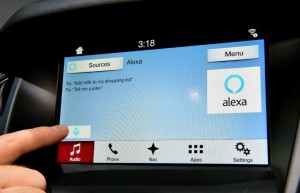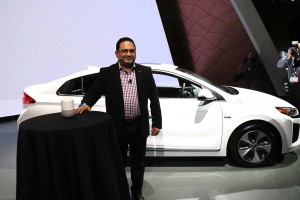Want to find your Nissan Murano in a crowded parking lot? Simply ask Alexa to honk its horn and then unlock the SUV.
Alexa is the wildly popular Amazon voice assistant more commonly used to check weather, set an alarm or play music. But with “her” ability to pair up with all sorts of devices linked to the Internet-of-Things, or IoT, Alexa is now finding fans in the auto industry where the race is on to connect cars to the rest of the world.
Later this month, Alexa users will be able to activate a “skill” pairing the voice assistant to Nissan ConnectServices, allowing them to remotely control a variety of vehicle functions, including unlocking the car’s doors, flashing its lights or honking the horn. Other automakers, including BMW and Ford are going further, integrating Alexa directly into their vehicles allowing motorists, among other things, to order a pizza or a coffee to go.
Nissan will allow Alexa to work with a variety of new and recent models, including the Murano crossover, the Altima sedan and the Titan pickup.
(Coffee to go? Starbucks and Ford team up with Alexa. Click Here for more.)
“Intelligent integration means helping our customers even when they are not behind the wheel,” said Dan Teeter, director of Vehicle Connected Services for Nissan North America. “We are about bringing unexpected innovations to customers, and are excited to offer this technology to both existing and new Nissan owners.”

Ford's partnership with Amazon's Alexa now means that driver can order and pay for their Starbucks from their Sync3-enabled vehicle.
In an era when the automobile is rapidly becoming a computer on wheels — with as many as 100 to 150 individual microprocessors, “connectivity” is becoming as important issue. It is one of the key areas that Ford Motor Co. intends to focus on, said new CEO Jim Hackett earlier this week, as he reported to industry analysts and the media on the results of his 100-day deep dive on the automaker’s future business strategy. That includes an “aggressive goal” of having 90% of the vehicles it sells worldwide able to connect to the Internet, among other things, by 2020.
Ford announced its own deal with Amazon at the Consumer Electronics Show back in January. “Ford and Amazon are aligned around a vision that your voice should be the primary way to interface with your favorite devices and services,” Don Butler, executive director, Ford Connected Vehicle and Services, said at the time. “Customers will be able to start their vehicles from home, and manage smart home features while on the road – making life easier.”
A few months later, the Detroit automaker introduced the first of what could become a series of services motorists will eventually be able to access with a verbal command. They now can use the voice assistant integrated into the Ford Sync3 infotainment system to order a cup of coffee and have it waiting at the nearest Starbucks, or get a pizza to go at Domino’s.
Amazon has been aggressively pursuing automakers, and it has made an offer that can be difficult to refuse, letting them freely integrate Alexa into their vehicles, or pair with a skill – the equivalent of a voice-controlled app – that can be used on standalone devices like the Echo and Echo Dot.
“Our mission is pretty clear, pretty simple: We’re here to bring Alexa into as many automobiles as possible over the upcoming years,” John Scumniotales, general manager for Amazon Alexa Automotive, told trade publication Automotive News earlier this year.
(Click Here for more about Hyundai adopting Google’s assistant.)
That’s in keeping with Amazon’s push to rapidly expand Alexa’s broader list of skills, which includes the voice assistant’s ability to control a range of IoT devices. With a simple command, a user now can adjust the temperature on a Nest thermostat, for example, open a garage door or turn on and off lights controlled by a variety of different Internet-connected switches.
BMW, another automaker launching a big push into connectivity, announced it was adding Alexa functionality to its vehicles last month. It promises motorists they will be able to access “tens of thousands of skills” already offered by the Amazon system.
“By making this step of integrating Alexa into our models from mid-2018, BMW (and its British sibling brand) Mini will form a more intrinsic part of our customers’ digital lifestyles,” said Dieter May, senior vice president, Digital Services and Business Models at the BMW Group. “Voice control first featured in BMW Group cars many years ago, and we are now enhancing its functionality by adding a digital ecosystem, which will open up all sorts of new possibilities that customers can access quickly, easily and safely from their car.”
Hyundai was one of the first manufacturers to add Alexa capabilities. As with other automakers, there is two-way functionality. A motorist can access the voice-assistant onboard, or use a skill to do things like open a Hyundai vehicle’s doors or fire up its engine remotely through devices like the Echo.
According to Hyundai, which can track how often owners use those features, “thousands” of commands are being issued each month, and that is expected to grow, both as more vehicles are sold with the functionality, and as consumers add Alexa-capable devices to their homes and offices.
Hyundai, however, also announced in April that it is giving its vehicles the capability of pairing up with Amazon’s most direct competitor, the Google Home voice assistant. And Apple, which already has its Siri capabilities integrated into many vehicles, may make a similar push when it launches as it rolls out its own hardware technology.
Indeed, motorists could wind up being overwhelmed with all the various ways they will be able to connect to the world. The Apple CarPlay and Google-controlled Android Auto systems are rapidly becoming ubiquitous, allowing drivers to display and control a variety of smartphone apps and functions on their touchscreens. Many already can access Apple’s Siri, as well as the manufacturer’s own voice control system. And in a bid to ensure no one gets left out, they may eventually offer all three of the voice assistants in the same vehicle, as well.
(Ford, Amazon want to Sync you up with Alexa. Find out more, Click Here.)
Such technologies could really hit their stride in the coming decade as the first autonomous and fully driverless vehicles start to roll out. With more time on their hands, industry forecasters expect travelers will want to be in even greater contact with the world around them. So, whether they will want to order lunch on the go, check the weather or put on some music or video entertainment, all they’ll have to do is ask.


